

Walter Greaves and the painters of Chelsea
1st - 10th October 2025
6 Mason’s Yard, Duke Street, St James’s, London SW1Y 6BU
(opens at 4.30 pm Wednesday 1st October; then Mon-F ri (10.45 am - 5.45 pm)
Late night opening until 7 45 pm (Wednesday 1st October)
further works and full cataloguing
Wal te r Greaves (1 846-1930)

above: Walter Greaves in his etched self portrait from 1900
In 1863, Walter Greaves, a Thames boatman and untrained artist met the great American painter, James Abbott McNeill Whistler. He subsequently became his studio assistant, mixing his paints, preparing his canvases and taking him out at night on his river boat to observe parts of the London river Greaves knew so well. The result of these trips were Whistler’s great nocturnes, including Nocturne: Blue and Gold, Old Battersea Bridge (1871-77) and Nocturne in Blue and Silver (1872-78). Yet by the end of the century Whistler had dropped Greaves. When in 1911 William Marchant launched a major exhibition at the Goupil Gallery rediscovering Greaves and suggesting that there was a far more significant mutual influence between the two artists, Whistler’s biographer Joseph Pennell accused Greaves of plagiarism, condemning his art once again to obscurity Despite widespread support from artists such as Augustus John, Walter Sickert and William Nicholson he was to die penniless in 1830 Today, although Greaves’s dating remains notoriously unreliable (he appears to have guessed when he painted many of his pictures), his reputation is being justly rebuilt His own nocturnes, of which the present painting is a fine example, can at their best show an inspiration and originality that are close to those by his master and are a perfect portrayal of the tones and shades of a river that Greaves perhaps knew better than any other artist of his age

Walter Greaves, RI (1846-1930)
Nocturne:Chelsea Reach
Signed l.r.: W.Greaves
Oil on canvas, 40 by 59 5 cm (15 ¾ by 22 ¼ ins)
£7,500
cat.1

Walter Greaves, RI (1846-1930)
The Greaves Boatyard, Cheyne Walk
Signed l.r.: W.Greaves
Wash over pen and ink, 23 by 37.5 cm
The Greaves family boatyard was established by Walter's father Charles and served as a landing stage for boats just off Cheyne Walk beneath Battersea Bridge Charles also had strong connections to significant British artists from the period taking Turner, John Martin and Holman Hunt onto the river His sons Walter and Henry continued the business and it was from here that Walter ferried Whistler on his trips on the Thames which would prove life-changing for the boatman-turned-artist
£2,200

Walter Greaves, RI (1846-1930)
Portrait of a Seated Lady
Signed: WGreaves
Coloured chalks, 10 1/2 by 8 ins (27 by 20 cm)
Provenance: with William Darby, Bond Street
£1,500
cat.1

cat 1
Walter Greaves, RI (1846-1930)
Battersea Reach
Watercolour and wash, 25 by 38 cm
Provenance: Bonhams Knightsbridge, Modern Pictures, 20 January 2004, lot 186
£2,200

cat 1
Walter Greaves, RI (1846-1930)
Old Battersea Bridge
Signed and with corrected date: W Greaves/?6
Pen and sepia ink, 24 by 31 cm
£1,100

cat 1
Walter Greaves, RI (1846-1930)
The Gates of the Cremorne Gardens
Black chalk ob buff paper,, 21 by 25 cm
£1,350

cat.1
Walter Greaves, RI (1846-1930)
The Last of Chelsea Regatta, 1871
Signed: W Greaves within the image lower left (on the weatherboard planks of the buildings).
Etching with drypoint (Artist's proof ), 26 2 cm x 55 5 cm (image plate)
Provenance:-"The Misses Dagnall, 48 Redcliffe Gardens, SW10" according to old labels verso
Literature:-Raymond Lister, Great Images of British Printmaking,, London, Robin Garton Ltd, 1978; Tom Pocock, "Chelsea Reach: The Brutal Friendship of Whistler and Walter Greaves, Hodder & Stoughton London 1970 [Illustrated on the dust jacket (the oil painting)]
£2,200

The scene, full of vivid incident and a characterful multitude of figures, is a depiction of the last traditional rowing regatta which took place in Chelsea in the summer of 1871 If the viewer follows the line of the Thames towards the horizon, the partly completed Albert Bridge (opened in 1873) can be identified spanning the river before Chelsea Bridge is reached (still known as Victoria Bridge at this stage) Bailey's Magazine of 1890 discusses how "Chelsea Regatta always attracted a numerous company, and under the old elms that grew on each side of Cheyne Walk, fun and sport of all kinds would be carried on "[1] The regatta used to be one of the highlights of the year in the Chelsea of old; Walter Greaves described how "what with guns firing, flags flying, bands playing and the immense crowd of people, Chelsea was pretty lively on the occasion of its annual Regatta The 'Adam & Eve', the headquarters of the sports, was crammed with people, and one wondered how it stood the strain of such a weight being a very old building This regatta, like the other river races made a remarkably artistic display of colour especially as it took place on a fine summer ’ s day, with blue skies and white clouds "[2] Greaves made several works relating to this event: an oil, now in the collection of Manchester City Art Gallery[3]; a watercolour of the same view, but without the crowd and a hand-coloured version of this etching [4[
Notes:-
[1] See p.228 "Bailey's Magazine of Sports & Pastimes", Volume 53, 1890
[2] Quoted from p 385, The Architect, Volume 107, 1922 and p 89, Tom Pocock, "Chelsea Reach", 1970
[3] See Manchester Art Gallery 1922.8
[4] Exhibited with The Fine Art Society, London, 2010 as "Chelsea Reach" [5] Royal Academy, 1872, Cat No 1298
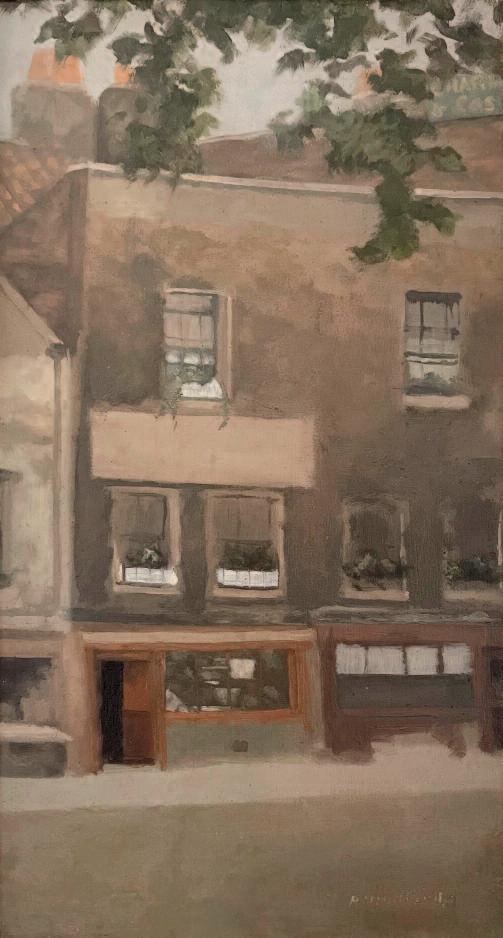
cat 9
Signed l r : W Greaves
Oil on canvas, 40 by 59 5 cm (15 ¾ by 22 ¼ ins)
£10,500
Paul Maitland (1863-1909)
Cheyne Walk
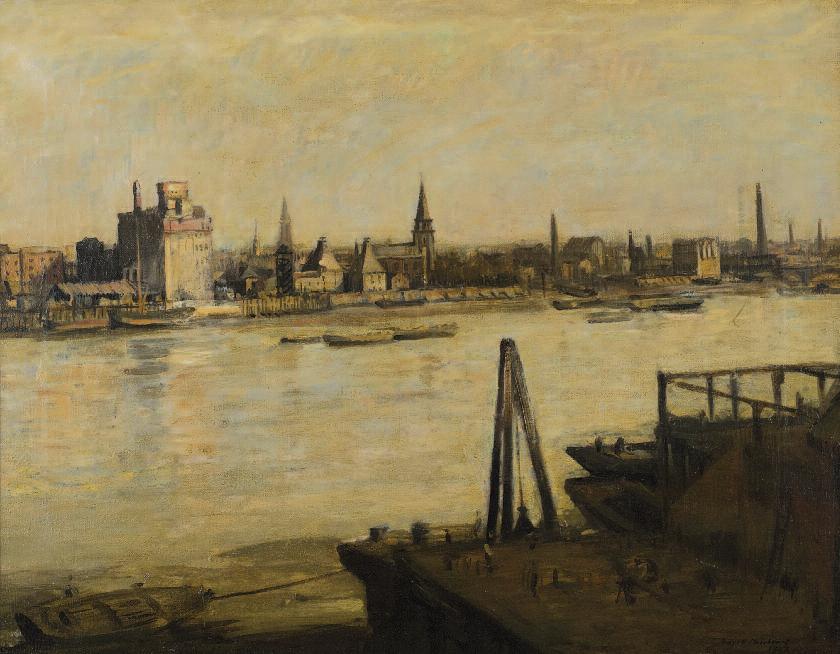
David Muirhead, ARA (1867-1928)
Nocturne:Chelsea Reach
Signed and dated l.r.: David Muirhead/1917
Oil on canvas, 54 by 69 cm
Muirhead lived on Cheyne Walk and executed a number of atmospheric views of the nearby Thames which show the clear influence of his neighbour there J.M.Whistler, whom he had known as a fellow member of the New English Art Club At least two known paintings of Battersea Reach by Murihead exist from 1917, the present work and another slightly larger version viewed from a lower vantage point on the river, which was presented to the Tate Gallery in 1918 through the National Art Collections Fund (inv.3323). That work was also exhibited at the New English Art Club in the summer of 1917 (no 94)
£3,900

Cheyne Walk, Chelsea
Signed and dated l.l.: Maria Eaton/11
Watercolour,
Provenance: Laurence Oxley, Alresford
£875
cat.9
Maria Eaton (1862-1944)

cat.9
Joseph Pennell (1857-1926)
The Thames, 1894
Signed Aquatint Plate size
20 5 by 26 5 cm , 8 by 10 in (frame size 42 by 46 cm , 16 by 18 in )
Whistler, a close associate, asked Pennell to accompany him to Paris and aid in the printing of his series of etchinga of Parisian shop fronts Inspired by Whistler, Pennell then produced a series of deeply atmospheric aquatint nocturnes of London and the River Thames Pennell and his wife wrote a biography of Whistler in 1906 and despite the opposition of his family over the right to use his letters it was published in 1908 In the early years of the 20th Century the Pennells made several trips to America resulting in a famous group of iconic etchings and mezzotints of the buildings of the growing New York.
Following the opening of Walter Greaves’s exhibition at the Goupil Gallery in 1911, Pennell was instrunental in launching a campaign that denounced Greaves as a plagiarist It was the failure of this exhibition that lead to Greaves’s descent into penury
£1,800
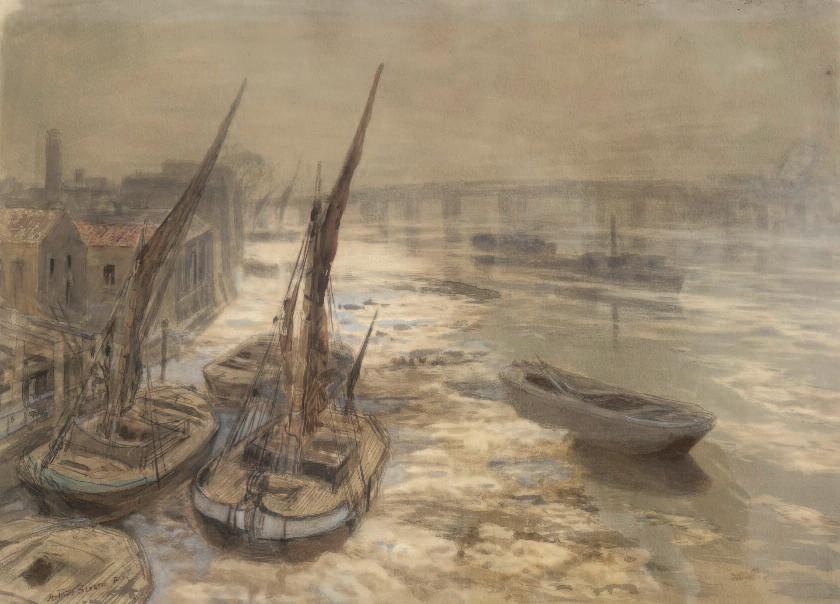
Joseph Arthur Palliser Severn, ROI (1842-1931)
Battersea Bridge; Chelsea Reach
Signed l l : Arthur Severn, RI
Watercolou and gouache over pen and ink, 30 by 42 cm
Provenance: acquired by the present owners from Abbott and Holder
£1,800
cat.9

Albert Ludovici, Jnr. (1852-1932)
Riders on Rotten Row, Hyde Park
Signed l l : Ludovici
Oil on canvas, 55 by 38 cm
Provenance: Christie’s New York, 30 October 1985, lot 218 (as part of a pair of Hyde Park paintings by the artist)
Ludovici was one of Whistler’s closest friends on the London art scene and his own delicately impressionistic views of the city are strongly in the American artist’s spirit and style. Mainly living in Paris, such views, like the present work, lend a sophisticated F rench style to the streets of London Widely exhibited in this country, Ludovici showed some 147 works at the Suffolk Street Gallery as well as at the Royal Academy from 1880 to 1897 and the Grosvenor Galleries He was also a member of the Royal Society of British Artists in close support of his friend Whistler
£3,900

Richard Westmacott, Jnr., RA (1799-1872)
A View from the Artist's Dining Room, 1 Kensington Gate
With extensive inscription on paper to the reverse of the original backboard Watercolour over pencil, 38 5 by 28 cm
Westmacott was from the third generation of the the most prominent family of sculptors in Britain of the era (both his father and grandfather were also called Richard)
£1,850
A Collection of Prints by Theodore Roussel

Theodore Roussel (1847- 1926)
The Corner of Cheyne Walk, Chelsea
Etching, unsigned, with the artist’s tab, signed in the plate, trimmed to the platemark with unsigned tab, printed in heavy tone, 13 by 19 cm , 5 ¼ by 7 ½ in
Provenance: Guy Roussel, the artist’s grandson
Literature: Margaret Dunwoody Hausberg, The Prints of Theodore Roussel: A Catalogue Raisonne, New York 1991, no 27 (trial proof)
cat.9
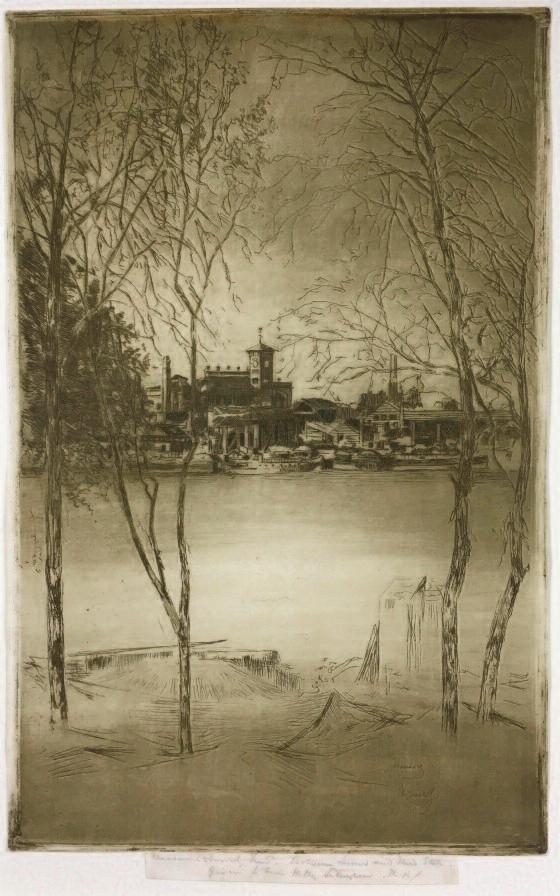
Theodore Roussel (1847- 1926)
Laburnums at Battersea
Etching, signed in the plate, trimmed to the plate mark and signed and inscribed on the tab: Theodore Roussel Inv Between Second and Third state Given to Miss Hetty Pettigrew Th R, 34 by 22 cm , 13 ½ by 8 ¾ in Literature: Margaret Dunwoody Hausberg, The Prints of Theodore Roussel: A Catalogue Raisonne, New York 1991, no 34
£1,400

Rex Vicat Cole (1870-1940)
Along the Mall at Night – Underground headquarters at St James ’
Park
floodlit
Signed l r: Rex Vicat Cole and inscribed with title on a label on the reverse Oil on panel, 26 by 35 cm , 10 ¼ by 13 ¾ in
One of a number of works that show the strong influence of the nocturnes of James Abbott McNeill Whistler on Vicat Cole, the present painting looks through the dark, abstract forms of night time in St James’s Park to the brightly lit beacon of 55 Broadway, the new London Underground headquarters, that had been finished a few years earlier in 1929 The work of the highly influential London Underground architect, Charles Holden, the building was awarded the RIBA London Architecture Medal in 1931 and was decorated with reliefs and sculptures by artists including Henry Moore, Eric Gill and Jacob Epstein
£3,800
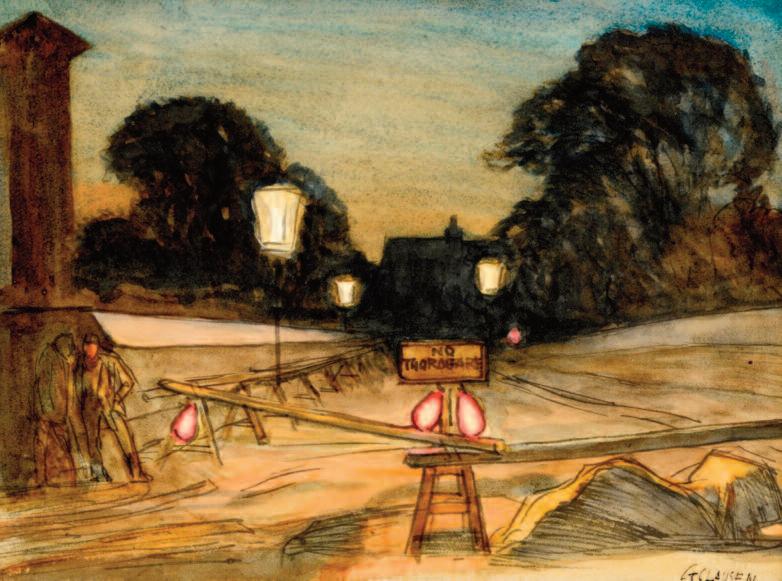
cat 9
Sir George Clausen, RA, RWS (1852-1944)
Roadblock near St John’s Wood at Night
Signed l r : G Clausen
Watercolour over pen and ink, 25 5 by 34 cm
Following Clausen’s move to St John’s Wood in north London in 1905 he embarked on a series of Whistlerian nocturnal subjects, including views of houses at night and atmospheric depictions of the London skyline. It is likely that this unusual roadblock scene is one such London subject and dates from the latter half of the artist’s career.
£1,900
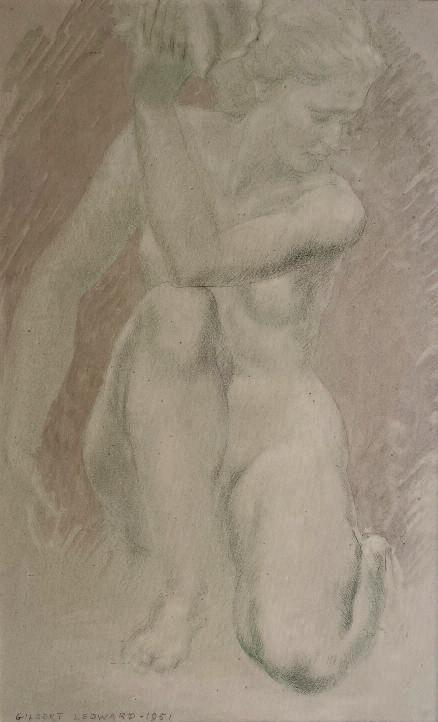
Gilbert Ledward, RA (1888-1960)
Study for the Venus Fountain, Sloane Square
Signed and dated l l : GILBERT LEDWARD 1951
Pencil and watercolour, 31 by 19 cm , 12 ¼ by 7 ½ in
The present work is a study for Ledward’s bronze nymph on the Venus Fountain (1952-3) standing in the centre of Sloane Square, Chelsea Sketches relating to this fountain were exhibited at the Royal Academy in 1953 and 1954 The fountain was paid for by the Leighton Fund which had been set up by Lord Leighton’s sisters for the purpose of placing works of art in or near public buildings. The inscription beneath the rim of the vase reads: Thames Run Softly till I End My Song..
£1,600

Walter Sickert, RA (1860-1942) Clarence Gardens, Camden Town
Signed l r : Sickert
Oil on canvas, 39 5 by 55 5 cm
Provenance: Savile Gallery, Paintings by Walter Sickert, May 1926, no 20; Marlborough Gallery, London; Anthony D'Offay; the Fine Art Society, London
Exhibited: London, Fine Art Society, Camden Town Group Centenary Exhibition, 2011 (illustrated)
Literature: Wendy Baron, Sickert Paintings and Drawings, New Haven and London, 2006, no 528 (illustrated)
Clarence Gardens was painted by a number of artists in the Camden Town Group, including both Harold Gilman and William Ratcliffe in around 1912 Sickert himself had a studio in Robert Street in the 1890s - a road that ran between Cumberland Market and Clarence Gardens. Although the square survives the housing around it was destroyed during World War Two
£38,000
cat.9

Margaret Gere (1878-1965)
Farwells at Paddington Station
Signed and dated l l : Margaret Gere/1948
Watercolour, bodycolour and pencil, 43 by 35cm (16¾ by 13¾ in)
Provenance: The Fine Art Society, London The Fortunoff Collection [7931]
Exhibited: Cheltenham, Cheltenham Art Gallery & Museums, Margaret Gere Exhibition, 21 January -3 March
1984, cat no D (illustrated as the cataloogue cover for the exhibition catalogue)
£3,950

c at 9
Barbara Jones (1912-1978)
Mural Design for the New Cake House, St James ’ s Park(a)
A Sheet of Designs for the New Cake House, St James ’ s Park(b)
Watercolour with gouache over pencil and collage on two joined sheets of paper, 66 by 69 cm (26 by 27 ¼ ins)
Provenance: the estate of the artist; with Jennings Fine Art
£3,500 (a)
£2,500 (b)

The New Cake House in St James’s Park was opened by Harold Wilson’s wife Mary on 23rd February 1970 Its interior mural was constructed in ceramic tiles by Richard Parkinson from original designs by Barbara Jones They depict the George III Jubilee celebrations held in the park in 1814 to commemorate one hundred years of the Hanoverian Dynasty. By the end of the century the structure came to be seen as outmoded (as well as being beset with structural issues) and was finally demolished (and the murals lost) to make way for the Inn in the Park (see Ruth Artmonsky, A Snapper Up of Unconsidered Trifles: A Tribute to Barbara Jones, 2008, pp 109-110; also The Pagoda and Chinese Bridge, St James’s Park, London, 1814, post on The Folly Flaneuse, November 15 2019)

Albert Edward Halliwell (1905-1987)
Poster Design for “The Lord Mayor ’ s Show ”
Original Design for a Poster, 1928
Signed, inscried and dated (1928) and further inscribed The Lord Mayor's Show/Experimental Poster Gouache with mixed media, 32 by 14 cm
A design for a currently untraced poster for the Lord Mayor's Show in 1928 Halliwell was experimenting with media for this subject, notable in the mottled effect in the paint, possibly created with the use of stencils A version of the poster also exists in collage cut-out form.
£1,850
cat 9

P.R.Dicks (fl.1920s)
“London is Bright Again ” , c.1945
Signed u r : P R Dicks
Gouache, 28 by 12 cm
£1,850



harry moore-gwyn british art
6 Mason’s Yard, Duke Street, St James’s, London SW1Y 6BU
(Mon-F ri - 10 45 am - 5 45 pm)(other times by appointment)
By appointment
Chalford, Gloucestershire
